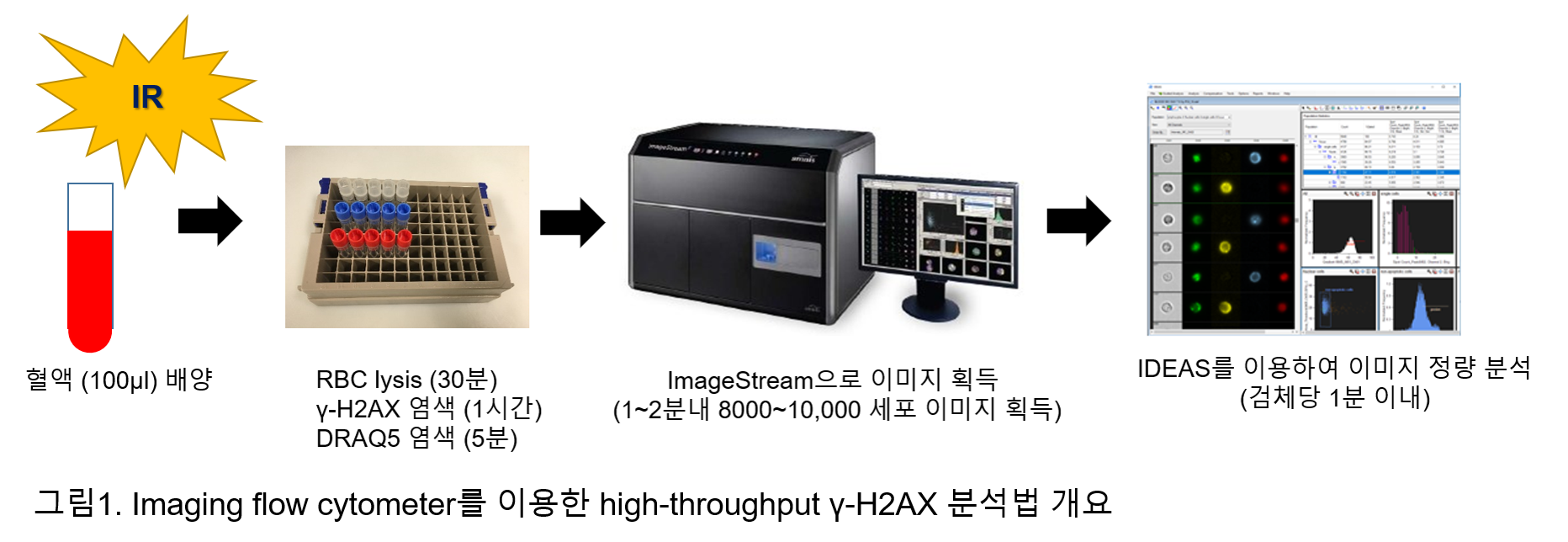글로벌 연구동향
방사선생물학
- 2019년 10월호
[Radiat Oncol.] Development of a high-throughput γ-H2AX assay based on imaging flow cytometry.KIRAMS / 이영현*
- 출처
- Radiat Oncol.
- 등재일
- 2019 Aug 22
- 저널이슈번호
- 14(1):150. doi: 10.1186/s13014-019-1344-7.
- 내용

Abstract
BACKGROUND:
Measurement of γ-H2AX foci levels in cells provides a sensitive and reliable method for quantitation of the radiation-induced DNA damage response. The objective of the present study was to develop a rapid, high-throughput γ-H2AX assay based on imaging flow cytometry (IFC) using the ImageStream®X Mk II (ISX) platform to evaluate DNA double strand break (DSB) repair kinetics in human peripheral blood cells after exposure to ionizing irradiation.METHODS:
The γ-H2AX protocol was developed and optimized for small volumes (100 μL) of human blood in Matrix™ 96-tube format. Blood cell lymphocytes were identified and captured by ISX INSPIRE™ software and analyzed by Data Exploration and Analysis Software.RESULTS:
Dose- and time-dependent γ-H2AX levels corresponding to radiation exposure were measured at various time points over 24 h using the IFC system. γ-H2AX fluorescence intensity at 1 h after exposure, increased linearly with increasing radiation dose (R2 = 0.98) for the four human donors tested, whereas the dose response for the mean number of γ-H2AX foci/cell was not as robust (R2 = 0.81). Radiation-induced γ-H2AX levels rapidly increased within 30 min and reached a maximum by ~ 1 h, after which time there was fast decline by 6 h, followed by a much slower rate of disappearance up to 24 h. A mathematical approach for quantifying DNA repair kinetics using the rate of γ-H2AX decay (decay constant, Kdec), and yield of residual unrepaired breaks (Fres) demonstrated differences in individual repair capacity between the healthy donors.CONCLUSIONS:
The results indicate that the IFC-based γ-H2AX protocol may provide a practical and high-throughput platform for measurements of individual global DNA DSB repair capacity which can facilitate precision medicine by predicting individual radiosensitivity and risk of developing adverse effects related to radiotherapy treatment.
Author informationLee Y1,2, Wang Q3, Shuryak I3, Brenner DJ3, Turner HC3.
1
Center for Radiological Research, Columbia University Irving Medical Center, 630 West 168th St, New York, NY, 10032, USA. younghyun.lee.0123@gmail.com.
2
Present Address: Laboratory of Biological Dosimetry, National Radiation Emergency Medical Center, Korea Institute of Radiological and Medical Sciences, 75 Nowon-ro, Nowon-gu, Seoul, 01812, Republic of Korea. younghyun.lee.0123@gmail.com.
3
Center for Radiological Research, Columbia University Irving Medical Center, 630 West 168th St, New York, NY, 10032, USA.
- 키워드
- DNA repair kinetics; High throughput; Human lymphocytes; Imaging flow cytometry; Ionizing radiation; Radiation sensitivity
- 연구소개
- 본 연구는 저자가 Columbia University Irving Medical Center에서 박사후연구원으로 근무할 당시 수행된 것으로, 현미경과 유세포분석기의 장점을 결합한 최신 장비인 imaging flow cytometry를 활용하여, 신속하고 정확한 방사선 노출 평가 및 개개인의 DNA 손상 복구 능력 평가를 위한 high-throughput 방법을 개발한 논문입니다. 본 논문에서는 소량의 전혈을 이용하여 백혈구의 분리 없이 단시간에 대량의 검체를 분석하는 방법 및 이를 토대로 DNA 손상 복구 능력을 평가하기 위한 알고리즘의 적용방법을 소개하고 있습니다. 이와 같은 방법은, 대규모 사고시 신속한 방사선 선량 평가 뿐 아니라 방사선 치료에 따른 개개인의 치료예후 등을 평가하고자 하는 연구자들에게 도움이 될 것이라 생각합니다.
- 덧글달기







